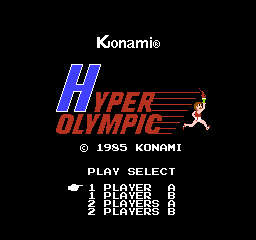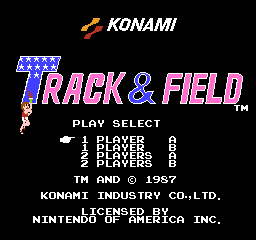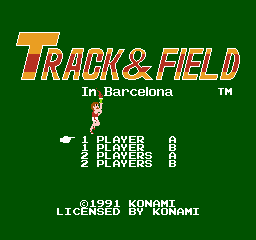Track & Field (NES)
| Track & Field |
|---|
|
Also known as: Hyper Olympic (JP), Track & Field in Barcelona (EU)
|
| To do: Document the changes made in the Genteiban release, which has a different sprite for the player character. |
Track & Field is the NES port of the Arcade game, now with two controllers replicating the original arcade experience (at least in Japan, as the game was reprogrammed internationally to use the NES controller). Notably this version was released in Japan a year after the Olympic Games Los Angeles 1984.
(Chariots of Fire theme plays)
Build Dates
At the beginning of the PRG ROM is an ID string that lists the game version and date.
| Japan | USA | Genteiban! (Japan) |
|---|---|---|
RC800 1,0 850325 |
RC800 X,0 850919 |
RD001 1,0 861220 |
In the European version, this is found at the end of the PRG ROM.
MSTR911014
Regional Differences
The international versions of Track & Field take the original Hyper Olympic and add all of the events from Hyper Sports, with the added events comprising the latter half of the game. The controls were also changed to use a standard NES controller instead of the Hyper Shot peripheral, the latter of which were likely included with the Famicom version because the standard controllers are hard-wired into the console.
Title Screen
| Japan | USA | Europe |
|---|---|---|

|

|

|
As Konami didn't publish the original Track & Field in Europe, Kemco thought they'd release it even though Track & Field II had already been released several years earlier. So what they did was simply make a title screen change and release it in time with the 1992 Barcelona Games. So thoughtful.
Unused Code
The dash, hurdles, long jump, and javelin events are programmed with cycle-timed code to split the screen into 5 independently horizontally scrolling areas. Two of those areas however, the audience and back wall, are always written with the same scroll value. The original arcade version of the game does scroll the audience and back wall at different rates.
The Track and Field and Hyper Sports series
| |
|---|---|
| Arcade | Track & Field • Hyper Sports • '88 Games |
| NES | Track & Field • Hyper Sports • Track & Field II |
| Game Boy (Color) | Track & Field • International Track & Field • ESPN International Track & Field |
| PlayStation | Nagano Winter Olympics '98 |
| Nintendo 64 | Nagano Winter Olympics '98 |
| Nintendo DS | New International Track & Field |
- Pages missing developer references
- Games developed by Konami
- Pages missing publisher references
- Games published by Konami
- Games published by Kemco
- NES games
- Pages missing date references
- Games released in 1985
- Games released in June
- Games released on June 21
- Games released in 1992
- Games released in February
- Games released on February 20
- Games with hidden development-related text
- Games with regional differences
- To do
- Track and Field and Hyper Sports series
Cleanup > Pages missing date references
Cleanup > Pages missing developer references
Cleanup > Pages missing publisher references
Cleanup > To do
Games > Games by content > Games with hidden development-related text
Games > Games by content > Games with regional differences
Games > Games by developer > Games developed by Konami
Games > Games by platform
Games > Games by publisher > Games published by Kemco
Games > Games by publisher > Games published by Konami
Games > Games by release date > Games released in 1985
Games > Games by release date > Games released in 1992
Games > Games by release date > Games released in February
Games > Games by release date > Games released in February > Games released on February 20
Games > Games by release date > Games released in June
Games > Games by release date > Games released in June > Games released on June 21
Games > Games by series > Track and Field and Hyper Sports series
The Cutting Room Floor > Unimportant Awards > NES games